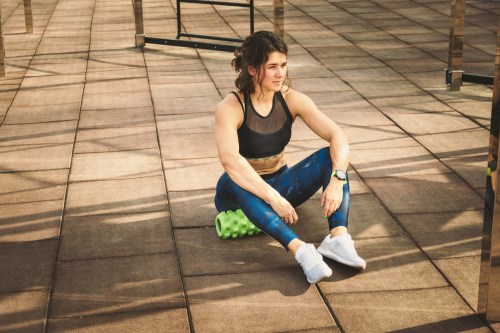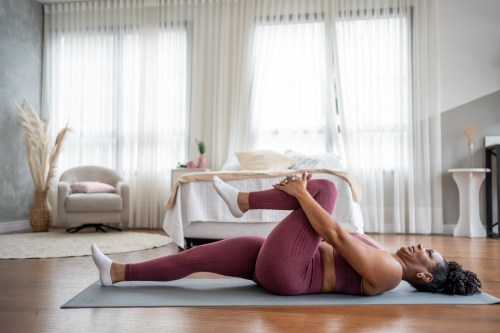Trainers say this is the one spot you should never, ever foam roll
If you've ever wondered: Can you foam roll your lower back? The answer isn't what you think. A physical therapist explains why it's not good for you.

Whenever I’m feeling muscle pain or some tightness in my body, I immediately grab a foam roller and roll that sh*t out. Sore quads? I just lie them down onto the recovery tool and move it along my thigh. And the same goes for my hamstrings. And my butt. But as soon as I started trying to foam roll my lower back (sup, lower back pain?!), a trainer in my gym came up to me and said that foam rolling your lower back is actually not a good idea. Cue the record scratch.
It may seem like the foam roller is the magical remedy to all muscle pain, but actually, that’s not the case. In fact, you can do more harm than good if you start rolling your lower back area. “When you think of typical foam rolling, like rolling out the calves or quads, you move up and down over that tight muscle,” says Danielle Weis, PT, physical therapist at Spring Forward Physical Therapy. “You don’t want to do that same type of rolling out with the spine. The vertebrae’s spinous prominences are bony and it can’t be really uncomfortable and irritating to roll up and down like that.”
Not only can it be kinda painful, but it can mess with your joints and lead to even more back pain, because foam rolling creates an “extension force” throughout your spine. “For someone with absolutely no spine issues, it could simply feel uncomfortable the first few times” explains Weis. “Over time, though, what it does is repeatedly jam the vertebral facet joints up against each other, and this can cause irritation of the joints that eventually leads to back pain.”
To make matters worse, foam rolling your lower back can mess with your mobility, and cause pain by mashing up your fascia, explains WundaBar founder Amy Jordan, adding that in certain cases it can exacerbate sciatica by overarching your lower back.
And if you have certain spinal issues, things can get much worse: “[Foam rolling the lower back] can be potentially dangerous, as it often forces the spine into more extension than it can handle,” says Weis, calling out conditions like stenosis, scoliosis, spondylolisthesis, or hyperlordotic. “Too much extension in these cases decreases the space of the spinal and foraminal canals and can lead to spinal cord and nerve impingement, and a multitude of issues can arise like shooting pain or weakness.” And if you’ve got a disc herniation, foam rolling can be too aggressive, and can lead to even more irritation of your discs and nerves.
That’s not to say that if you have lower back pain, there’s absolutely nothing you can do at home or in the gym to stretch things out—there are just better ways to do it than with a foam roller. Instead of moving around with the tool, Weis suggests lying on top of one with your arms out to the side, which can help open up the front of your shoulders and chest. (I can attest that this feels really good.) Another trick? Take a small ball to roll out your muscles in a more targeted way, which allows you to get into the muscles without rolling over your bones (hey there, spine and ribs). Weis suggests doing this super slowly with coordinated breathing, and adds that it should “always feel like the muscle is being released, but not be painful.”
Jordan also recommends a flat back stretch with your hands on a countertop and body in an “L” shape with your feet four inches apart in parallel. “You can add in fascial flossing by alternating a micro-bend in each knee without lifting your heels or rocking hips,” she says. So keep your foam roller tucked away when you’re working on your lower back.
To better deal with that spine, try these gentle yoga twists for lower back pain. And here are bras for back pain to wear that can help, too.
Sign Up for Our Daily Newsletter
Get all the latest in wellness, trends, food, fitness, beauty, and more delivered right to your inbox.
Got it, you've been added to our email list.










